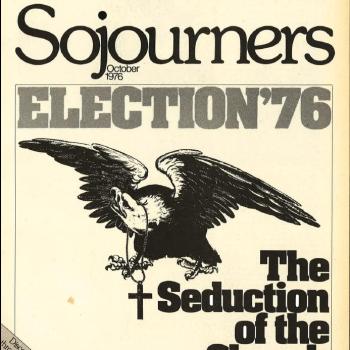Today I’m happy to welcome to the blog Angela Tarango, Professor of Religion at Trinity University in San Antonio, TX. Angela’s first book, Choosing the Jesus Way: American Indian Pentecostals and the Fight for the Indigenous Principle (University of North Carolina Press, 2014) won the PNEUMA Book Award for Best Book in Pentecostal/Charismatic Studies. She is currently on a Louisville Sabbatical Grant for Researchers and working on her next book manuscript, which examines Tejano Methodism and material culture during the Covid-19 pandemic.
Early one morning in the summer of 2019, I walked into La Trinidad United Methodist Church (LTUMC) and came upon a surprising sight. The United Methodist Women’s group was preparing the gym for a funeral reception. Along with the coffee and iced tea that was brewing and an abundance of sheet cake, was the fact that the entire gym was decorated in orange. Orange tablecloths were everywhere, with a group of women putting orange flowers into Whataburger bags bearing the burger chain’s trademark orange stripes. Curious, I asked one of the women what was going on. She responded “Oh, Brother V he loved his Whataburger, and he was a big Longhorns fan, so we wanted him to have a funeral reception he would have enjoyed.” I was both surprised and charmed by the display. The church ladies were giving Brother V a reception that spoke to the things that he loved, something that would hopefully make his family smile through the grief, all wrapped up in the fellowship that Mexican-American Methodists usually partake in after the funeral. Another church member told me, “This is what we do. Gather in fellowship after a friend is buried. Share good memories and tell stories. Spend time with the family and have some coffee and cake.”

The study of material culture among Christians began with a focus on the obviously religious — the physical statues of saints, prayer cards, religious paintings, and has over time been expanded to include other markers of Christianity. But my time undertaking ethnography at LTUMC has led me to consider other aspects of materiality among Tejano Methodists. Memorial plaques, walls of pictures, stained-glass windows with names of prominent Methodists on them. An entire room full of church memorabilia. The pictures of the quilts made by the women’s quilting group, the banners that hang in the front of the church and that are changed according to holiday or liturgical season. The decorations for funeral receptions, or for Vacation Bible School.
The people of LTUMC are constantly creating, staking out a place, and reinforcing their importance in Methodist history through their use of material culture on both a micro and macro level. On a micro level, the church uses everyday acts of materiality, the creation of the banners, the funeral reception decorations, the tacos served every Sunday morning pre-pandemic, specifically to serve the physical and spiritual needs of the congregation. But on a macro level the people of LTUMC — Tejano Methodists who have long been ignored by traditional histories of the UMC — created their own history that staked a claim within the broader story of American Methodism. This particular history was etched into the photos, the plaques, the collection of treasured and rare documents in their history room, and in the body of the building of their church. Their denomination may ignore the history of Tejano Methodism, but through their material culture, LTUMC refuses to let their story disappear.
Take, for example, the photos. LTUMC has an abundant number of framed pictures of the church on its walls, going back to the period after the Mexican Revolution when the church grew due to migration, into its heyday in the 1950s as the largest Latino UMC church in the United States. One might assume that the pictures are mainly decorative, or that the church members pay little attention to them, but I discovered that the pictures function as far more than that. Every time I pause to look at a picture it is not uncommon for a church elder to come to me and to point out an ancestor—a parent or grandparent, or sometimes, themselves at age four or five dressed up for church. At first, I thought they were just trying to explain the pictures to me, but I realized that what they were doing was creating and re-creating family and Tejano Methodist history. By explaining the familial ties to certain preachers, or prominent families in the church, they claimed a place in La Trinidad’s story and staked out their own social place within the church.
While many churches simply buy their own banners from liturgical supply stores, a small group of women at La Trinidad make their own for the church. The making of the banners is a complicated and intricate creative process. A design is selected, then must be traced onto butcher paper while being projected onto a wall in order to be large enough to create a template for the banners which average six to seven feet in height. The fabric must be selected, backed and sewn with interfacing to hang straight, and then the actual design must be sewn or appliqued onto the banners. Given the amount of work that the women do, the creation of banners often takes up to several months at a time for a set. Why do the women do the work? Well they all enjoy it, they love each other’s company but they also understand that their banners reflects the story the church at a particular moment. While public facing works of art, the banners are a quiet monument to the durability of women’s unseen labor within Methodism.

But it was the Covid-19 pandemic that forced me stretch my understanding of the material at LTUMC. When the pandemic hit in March 2020, LTUMC shut down in person worship. Since it already had a streaming channel on YouTube and a camera at the church, the pastors adapted quickly and continued to host services online with the help of a couple singers. All the lay ministries were suspended, frozen in a liminal space and time. While other Texas churches opened as soon as restrictions were lifted, LTUMC stayed online-only for more than a year. In March of 2021, thanks to a fortuitous donation, the church organized a vaccine drive for all its members, the people who lived in the surrounding neighborhood, and for staff at the school located across the street. The pastors personally called all those who qualified and worked hard to convince any who were vaccine skeptical. As the nurses gave out the first vaccine, LTUMC’s silenced gym came alive with people chatting and listening to music as they waited the customary 15 minutes after vaccination. One church elder said to me “So much excitement mija! It reminds me of the day I got my polio vaccine. We were all so relieved!” The church achieved a 95% vaccination rate among its adult members, a staggering example of it meant to love thy neighbor in a state where vaccines had become political.
The second Pfizer vaccine was distributed on Holy Thursday, with the head pastor offering communion to all those who came in to get their second shot. Church members partook in a quiet reverence before walking in. Some of the neighbors and school staff shyly waved away the host and grape juice cups, while other paused and asked if it was okay if they weren’t Methodists, and when the pastor explained that LTUMC had an open table, they took the offered communion, with many people crossing themselves after. A local Black Methodist pastor praised God for the vaccine as he talked to the LTUMC pastors after receiving his shot; a deaf man from the neighborhood waved his vaccine card in excitement and nodded thanks after communion; and a teacher from the school whispered a fervent prayer after receiving and effusively thanked the pastor.

It was at this moment, on a breezy Texas spring day, that I realized the most concrete form of materiality among the people of LTUMC: the church’s care for its congregants’ bodies and health in the form of the Covid-19 vaccine, offered along with the symbolic body and blood of Christ shared among the members and their neighbors. In the middle of a pandemic, they embodied the famous quotation attributed to John Wesley: “Do all the good you can, in all the ways you can, in all the places you can, to all the people you can, as long as you ever can.”












